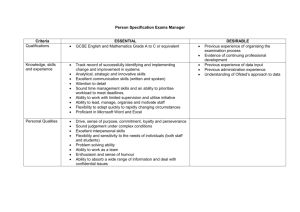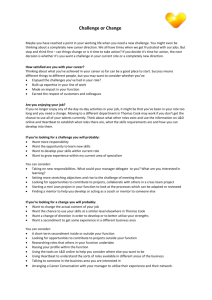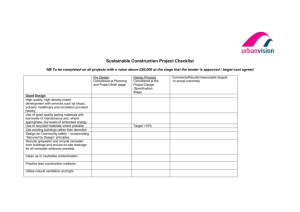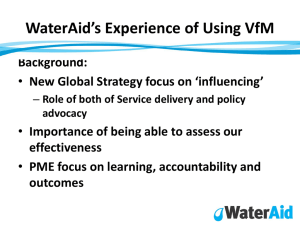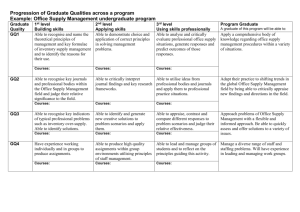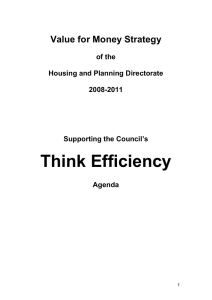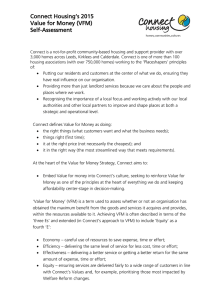How to Engage with a Service Review Sue Thiedeman and Howard Simmons for
advertisement
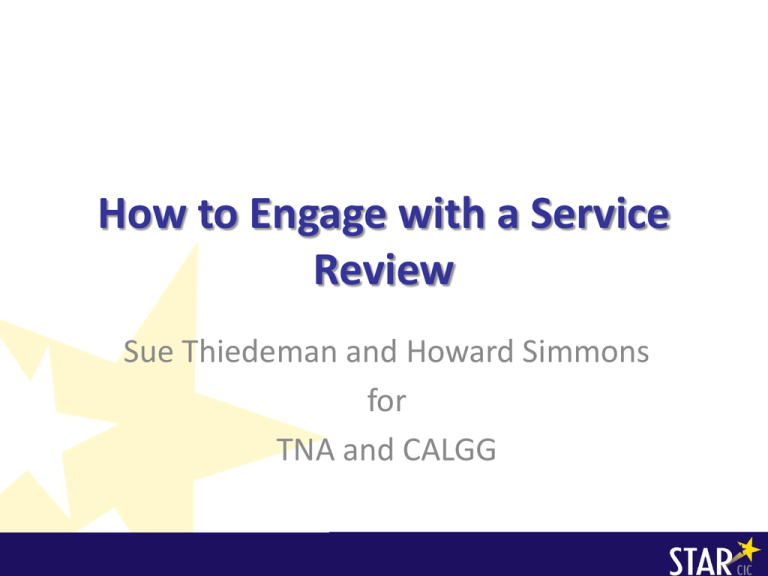
How to Engage with a Service Review Sue Thiedeman and Howard Simmons for TNA and CALGG What’s on the Horizon The Context • • • • Economic Climate Local Government Finance Comprehensive spending review (s) Changes to the way Local Government is funded • Impact on Local Government Finance • Tough decisions required Funding Outlook for Councils Funding Changes • No longer by formula grant • Linked to incentives – Building new homes – Business rates retention ( thriving economy) – Creating jobs (growth and reduction in benefits / increased council tax) – Level of council tax CSR Cuts to Local Government Impact on Public Services 110 Environmental Index (2009-10=100) 100 90 Cultural Highways and transport 80 Housing 70 Planning and development 60 50 2009-10 2010-11 2011-12 2012-13 Corporate Priorities • Key Strategic Documents • Based on the needs of the area including big priority areas: • The approach to service cuts will depend on the corporate priorities • Different ways to make a service more efficient • Members are making difficult decisions The Service Review • Different levels and approaches • Service/Departmental/Thematic/Directorate/ Council wide/Partnership • Core elements include: Why provide? - Mandatory/Discretionary baseline Inputs - Budgets/Staffing/Accommodation Outputs - usage/transactional costs/VFM Outcomes - delivery against Corporate agenda Transformation – doing differently or not at all The Service Review Rudyard Kipling – “The Elephant Child” I have six honest serving men They taught me all I know I call them What and Where and When And How and Why and Who Business Process Reengineering/Transformation • Internal or External Challenge and change agents • Sector led Improvement/peer review/self assessment • External Business Partners – Capita/KPMG/PWC • Search for VFM and Continuous Improvement • Economy/Efficiency/Effectiveness/Equity in processes and outcomes Lessons Learnt to Date • • • • • • Understand the Context Clear Statement of Purpose and Outcomes People/Staff are key to Improvement Consult Staff, Users, Community Challenge Attitudes and Performance Support Management of Change – different ways of organising/delivery • Clear Evidence Base Key Questions • • • • • Need for the Service? Clear and Challenging Aims? Contribution to Corporate Priorities? Effective Performance Management? Comparison with Similar Services – performance and cost? • Scope for Improvement – Direction of Travel? Lean Thinking • Focus on the customer/client/user • Identify and understand how the work gets done – the value stream • Manage, improve, and smooth the process flow • Remove Non-Value-Added (NVA) steps and waste • Manage by fact and reduce variation • Involve and empower the people in the process • Undertake improvement activity in a systematic way Six Sigma • Application of the DMAIC methodology • Define/Measure/Analyse/Improve/Control • Structured, rigorous approach to process improvement • Goal is to achieve 3.4 defects per million parts (or opportunities of doing it wrong) known as 6 Sigma with value stream mapping • “Kaizen” – Continuous Improvement Survival Guide • • • • • • • Be Proactive Be Strategic Be Systematic Understand the Evidence base Demonstrate Outcomes/Value Added Identify Champions and Advocates Build Partnerships Small Group Exercise • Pitfalls of a service review – Think about possible pitfalls of a service review – Share your experiences Case Study • Richard Taylor – York • Caroline Sampson - London Preparing For a Service Review • Do a review yourself • The new accreditation standard is a good opportunity • Consider the Culture and Sport Improvement Tool – An evidence based self – assessment benchmark – Covers the 8 themes of excellent organisations • Benchmark information on other similar services – – – – How many staff they have What they cost Performance – number of users etc Range of activities • Utilise peers or critical friends and be open to challenge The Right Kind of Evidence • Make sure you are comparing like with like and be able to explain differences – Number of staff – Size of service – The offer? • Financial information • VFM - Cost / performance / satisfaction? The Impact of Your Service • • • • • • What does your service do? What difference does it make ? Who uses the service and who doesn’t? What do people think of you? Utilise your internal and external customers Emphasise your statutory responsibilities – TNA Guidance Meeting Strategic Outcomes • How does your service fit into the bigger picture ? • Demonstrate how you meet the Council’s strategic objectives • Culture and Sport Outcomes Framework – Logic Model – Outcomes Triangle – Evidence – Performance Indicators Outcomes Framework Exercise • Think about how your service meets strategic Outcomes – Health and Wellbeing – Economic Growth – Learning / Education attainment Engaging Local People • • • • • How does your service engage local people? Who do you engage with? Who don’t you engage with? – Equalities Impact Assessment What VALUE does your service add to local people • What are satisfaction levels ( users / non users)? Raising your profile • Who knows about your service, what it is and what it does? – Ideas for “Making News” • Press and PR • Social media • Events and activities • Make the most of your key relationships • Utilise your stakeholders to support you and advocate on your behalf Stakeholder Mapping Effective Advocacy • • • • Advocating effectively is absolutely critical Need to be proactive in promoting the service Maximise your key relationships Advocacy Exercise – An opportunity to practice your pitch – Designed to help you think about key messages to different audiences Evaluation • Utilise your Action Planning Log • What happens next – Another seminar in London 14 July – Develop and share legacy documents • Evaluation – utilise flip sheet charts and post it notes • Close
